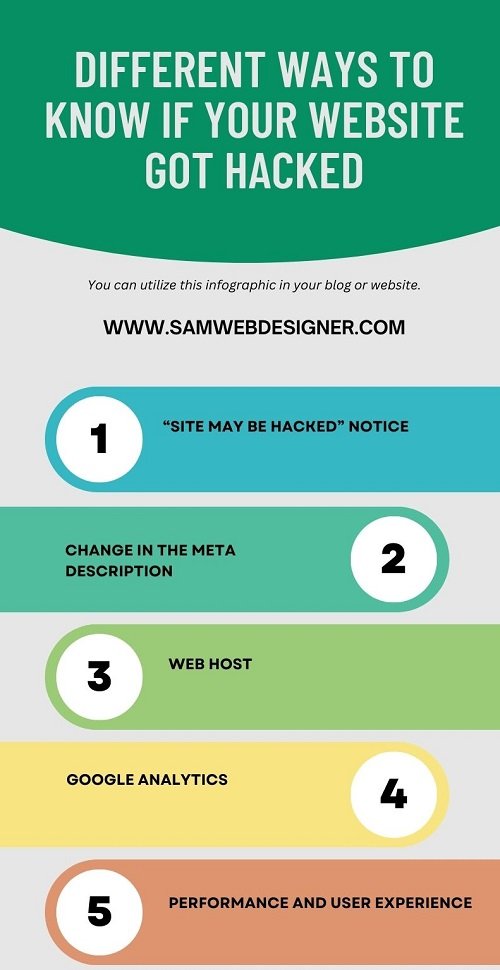This article will discuss 5 signs on your website that indicate that it got hacked.

1. “Site may be hacked” Notice
Whenever Google detects any unusual or potentially harmful actions taking place on your website, it creates a notification stating “This site may be hacked.”
This notification serves as a warning to potential visitors, prompting them to steer clear of your website. As a result, there is a significant decrease in the natural, unpaid traffic to your site.
However, it’s important to note that this message can also appear due to certain external text formatting that you might have applied to your content. To pinpoint the exact cause, you can utilize the Google Search Console tool.
2. Change in the meta description
Hackers might exploit your website to improve their SEO rankings or boost their sales through affiliate links. As a result, the descriptions of your web pages could change on search engines.
The primary method to detect this is by examining your meta descriptions to see if they have been tampered with or replaced by misleading content.
If you click on the compromised website, the link could redirect you to a completely different website or page, or even to a blank page.
3. Web Host
A website performance enhancement service, commonly known as a web boost, can also serve as a warning system for potential hacking activities.
There are specific signs that indicate a website might have been compromised. For instance, if your web hosting provider unexpectedly sends you an email about excessive server usage, this could be an indicator of malware infiltration.
Furthermore, the Web Boost service might identify your website as unsafe and temporarily take it offline to safeguard other websites sharing the same server resources.
In such a scenario, you won’t be able to access your website until the security issues have been resolved.
4. Google Analytics
The Google Search Console employs a specific algorithm that thoroughly assesses each submitted website and highlights any security concerns that might arise.
It not only provides information about the traffic your website receives, but it also notifies you about variations in specific metrics, such as sudden surges in traffic, higher bounce rates, and decreased conversions. These changes could potentially indicate a threat to the well-being of your website.
5. Performance and user experience
If your website gets hacked, you might observe certain noticeable signs. Even though these indicators can be quite subtle and easy to overlook, you can identify a pattern that points to issues that might otherwise remain unnoticed. One evident effect is a slowdown in your website’s performance, often caused by malicious files inserted by hackers.
In some cases, hacked websites become unreachable, and their resources are exploited extensively. Additionally, you may receive numerous complaints from visitors who notice unusual patterns on your website, or they might encounter difficulties while attempting to log in.
These represent subtle signals that suggest a potential hack on your website. To confirm this, you can run scans using various malware scanners, tools, or plugins. Alternatively, you can manually inspect your website and review your activity logs to gather more information.
Conclusions
In conclusion, safeguarding your website from potential hacking threats requires vigilant monitoring and swift action. Google’s “Site may be hacked” notice serves as an initial line of defense, cautioning visitors about suspicious activity.
Alterations in meta descriptions and unexpected web hosting notifications can signal compromise, while Google Analytics helps track anomalies in traffic and user engagement.
Performance and user experience issues, like slow loading times and unusual patterns, can also signal a breach. Detecting such subtle signs demands a proactive approach, employing malware scanners, tools, or manual checks to ensure website security and maintain a seamless online presence.

